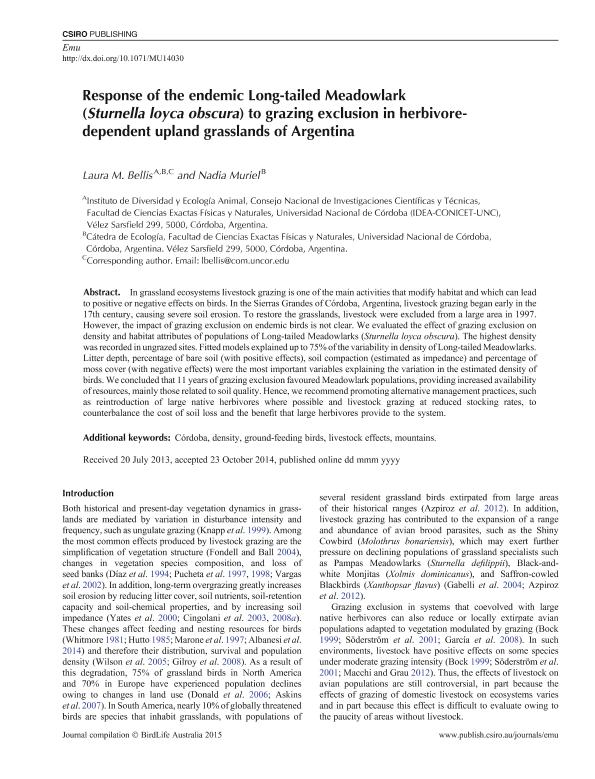Mostrar el registro sencillo del ítem
dc.contributor.author
Bellis, Laura Marisa

dc.contributor.author
Muriel, Nadia
dc.date.available
2016-11-04T16:03:54Z
dc.date.issued
2015-04
dc.identifier.citation
Bellis, Laura Marisa; Muriel, Nadia; Response of the endemic Long-tailed Meadowlark (Sturnella loyca obscura) to grazing exclusion in herbivore-dependent upland grasslands of Argentina; Csiro Publishing; Emu; 115; 2; 4-2015; 176-184
dc.identifier.issn
0158-4197
dc.identifier.uri
http://hdl.handle.net/11336/7978
dc.description.abstract
In grassland ecosystems livestock grazing is one of the main activities that modify habitat and which can lead to positive or negative effects on birds. In the Sierras Grandes of Córdoba, Argentina, livestock grazing began early in the 17th century, causing severe soil erosion. To restore the grasslands, livestock were excluded from a large area in 1997. However, the impact of grazing exclusion on endemic birds is not clear. We evaluated the effect of grazing exclusion on density and habitat attributes of populations of Long-tailed Meadowlarks (Sturnella loyca obscura). The highest density was recorded in ungrazed sites. Fitted models explained up to 75% of the variability in density of Long-tailed Meadowlarks. Litter depth, percentage of bare soil (with positive effects), soil compaction (estimated as impedance) and percentage of moss cover (with negative effects) were the most important variables explaining the variation in the estimated density of birds. We concluded that 11 years of grazing exclusion favoured Meadowlark populations, providing increased availability of resources, mainly those related to soil quality. Hence, we recommend promoting alternative management practices, such as reintroduction of large native herbivores where possible and livestock grazing at reduced stocking rates, to counterbalance the cost of soil loss and the benefit that large herbivores provide to the system.
dc.format
application/pdf
dc.language.iso
eng
dc.publisher
Csiro Publishing

dc.rights
info:eu-repo/semantics/openAccess
dc.rights.uri
https://creativecommons.org/licenses/by-nc-sa/2.5/ar/
dc.subject
Abundance
dc.subject
Grasslands
dc.subject
Livestock Grazing
dc.subject
Sturnella Loyca Obscura
dc.subject.classification
Conservación de la Biodiversidad

dc.subject.classification
Ciencias Biológicas

dc.subject.classification
CIENCIAS NATURALES Y EXACTAS

dc.title
Response of the endemic Long-tailed Meadowlark (Sturnella loyca obscura) to grazing exclusion in herbivore-dependent upland grasslands of Argentina
dc.type
info:eu-repo/semantics/article
dc.type
info:ar-repo/semantics/artículo
dc.type
info:eu-repo/semantics/publishedVersion
dc.date.updated
2016-11-03T19:17:43Z
dc.journal.volume
115
dc.journal.number
2
dc.journal.pagination
176-184
dc.journal.pais
Australia

dc.journal.ciudad
Collingwood
dc.description.fil
Fil: Bellis, Laura Marisa. Consejo Nacional de Investigaciones Cientificas y Tecnicas. Centro Cientifico Tecnologico Cordoba. Instituto de Diversidad y Ecologia Animal; Argentina. Universidad Nacional de Cordoba. Facultad de Cs.agropecuarias. Departamento de Recursos Naturales. Catedra de Ecologia Agricola; Argentina
dc.description.fil
Fil: Muriel, Nadia. Universidad Nacional de Cordoba. Facultad de Cs.exactas Fisicas y Naturales. Departamento de Diversidad Biologica y Ecologica. Catedra de Ecologia; Argentina
dc.journal.title
Emu

dc.relation.alternativeid
info:eu-repo/semantics/altIdentifier/url/http://www.publish.csiro.au/mu/MU14030
dc.relation.alternativeid
info:eu-repo/semantics/altIdentifier/doi/http://dx.doi.org/10.1071/MU14030
Archivos asociados
